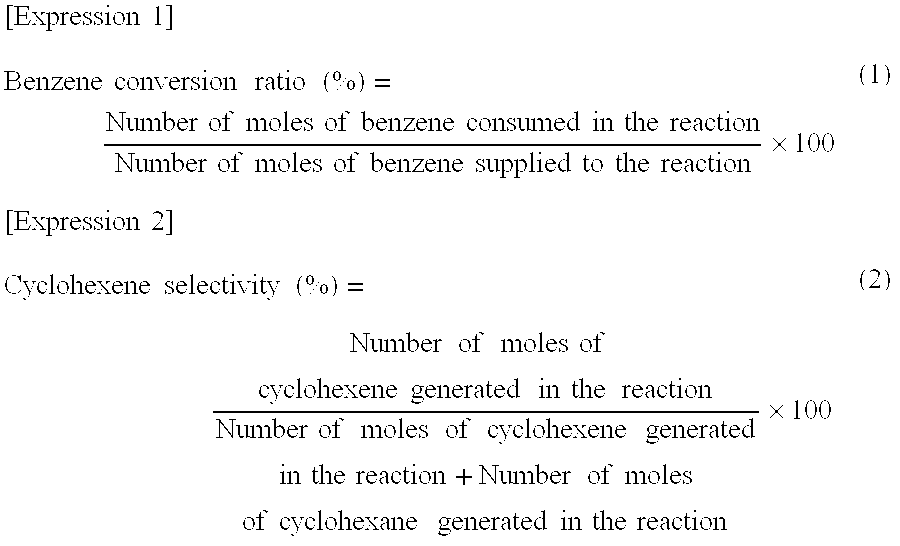Catalyst for cycloolefin production and process for production
a technology of catalyst and cycloolefin, which is applied in the field of catalyst for cycloolefin production, can solve the problems of carrier dissolution, low selectivity of conventional processes, peeling and agglomeration, etc., and achieves excellent performance, improves handleability, and suppresses peeling and agglomeration
- Summary
- Abstract
- Description
- Claims
- Application Information
AI Technical Summary
Benefits of technology
Problems solved by technology
Method used
Image
Examples
example 1
(1) Porous Zirconia Material Synthesis
[0080]While stirring 500 g of a hafnium oxide-containing zirconia sol (nitric acid stabilizer-solution with a 10 wt % zirconia content; manufactured by Newtecks Co., Ltd.) at 40° C., 25% ammonia water was slowly charged thereto. This solution was stirred for 1 hour under heating at 80° C., and then subjected to reduced-pressure drying at 90° C. using an evaporator to thereby form a solid. This mass of solidified powder was ground, then, using 0.5 N sodium hydroxide, mixed under stirring into an aqueous alkali solution for 1 hour at 60° C. The resulting solution was then repeatedly washed with water and filtered. The resulting filtrate was then dried at 110° C. using a vacuum dryer, which was then calcined at 250° C. to yield 47 g of a white powder. Results of measurement of the specific surface area and pore distribution of this white powder using a nitrogen adsorption and desorption method showed 1.5 wt % hafnium oxide-containing zirconia which...
example 2
[0083]A hafnium oxide-containing porous zirconia material was synthesized in the same manner as that of (1) in Example 1, except that 45 g of white powder was yielded by charging the above-describe zirconia sol into a 1 liter autoclave, wherein the synthesis time was extended to 10 hours at 120° C., and the calcining conditions were changed to 400° C. Results of measurement of the specific surface area and pore diameter of this white powder using a nitrogen adsorption and desorption method showed a specific surface area of 109 m2 / g, a pore volume of 0.34 cm3 / g, and an average pore diameter of 5.9 nm. The pore volume of pore diameters 2.5 to 15 nm was 66.4% by volume of the total pore volume of pore diameters 2 to 150 nm. It was learned from observation using an electron microscope and particle size distribution measurement for seeing the particle structure of this powder that the physical properties of the powder were an average primary particle diameter of 10.1 nm and an average se...
example 3
[0084]A 1 liter autoclave was charged with 4 g of the solid catalyst prepared in Example 2 and 280 ml of an aqueous 10% by weight zinc sulfate solution, and purged with hydrogen while stirring. The temperature was raised to 170° C., and then hydrogen was further added under pressure to give a total pressure of 5 MPa. The resulting solution was left in this state for 140 hours then subjected to reaction pre-processing of the catalyst slurry. The autoclave temperature was subsequently lowered to 150° C. and the pressure to 3 MPa, then 140 ml of benzene were added under pressure along with hydrogen. The resulting solution was reacted under high-speed stirring at a total pressure of 5 MPa. Reaction solution was removed from time to time to obtain the analysis of the oil-phase composition by gas chromatography. Cyclohexene selectivity and the activity with respect to ruthenium were measured when the ratio of benzene conversion was 50%. The reaction results are shown in Table 1. The post-...
PUM
| Property | Measurement | Unit |
|---|---|---|
| crystallite diameter | aaaaa | aaaaa |
| particle diameter | aaaaa | aaaaa |
| particle diameter | aaaaa | aaaaa |
Abstract
Description
Claims
Application Information
 Login to View More
Login to View More - R&D
- Intellectual Property
- Life Sciences
- Materials
- Tech Scout
- Unparalleled Data Quality
- Higher Quality Content
- 60% Fewer Hallucinations
Browse by: Latest US Patents, China's latest patents, Technical Efficacy Thesaurus, Application Domain, Technology Topic, Popular Technical Reports.
© 2025 PatSnap. All rights reserved.Legal|Privacy policy|Modern Slavery Act Transparency Statement|Sitemap|About US| Contact US: help@patsnap.com


